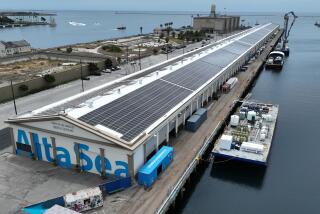$10-Million Offer May Be Winner for Batiquitos Lagoon
- Share via
CARLSBAD — In an unusual proposal that has the tentative endorsement of both environmentalists and developers, the Port of Los Angeles and Pacific Texas Pipeline Co. may provide as much as $10 million for the restoration of Batiquitos Lagoon.
If approved by a myriad of state, federal and local agencies, the proposal would permit port officials and developers of the Texas oil pipeline to meet federal requirements that they compensate for environmentally valuable tidal land lost to their planned projects by paying for enhancement efforts at Batiquitos.
“The port and the Pacific Texas Co. are proposing some major landfills inside the port’s breakwater, totaling some 455 acres,” said Vern Hall, the Los Angeles port’s project manager. “This will affect the marine fisheries habitat there, so in order to do this, we are required by law to offset (the loss of those acres) elsewhere.”
In the past, the port has “mitigated,” or compensated for ecologically sensitive land swallowed up by development, within the San Pedro harbor.
“But we’re running out of room,” Hall said, “so we’re turning to off-site mitigation. And Batiquitos fits the bill perfectly.”
Although negotiations are still in progress, all sides appear to agree that the proposal could be a virtual godsend for the lagoon. Until now, there were numerous plans for restoring Batiquitos but few ideas on how to fund the often costly and complicated improvements.
Now, “we’ve got someone with restoration plans that dovetail with what we want to do ecologically and who is willing to shoulder the financial burden,” said Jon Briggs, vice president of Sammis Properties, which plans a development on the lagoon’s northwestern shore.
Ann Omsted, a founder of the Batiquitos Lagoon Foundation, expressed cautious agreement: “I’m afraid to say anything, because it sounds too good to be true and I wouldn’t want to jinx it,” Omsted said.
“But certainly, if someone is going to pump millions of dollars into restoring our lagoon, I’m very excited about it.”
Still, there are misgivings about the plan in at least one corner--the state Coastal Conservancy. Laurie Marcus, a project analyst with the agency who is responsible for coordinating restoration efforts at Batiquitos, said she is not convinced the port’s plans will meet the environmental needs of Batiquitos.
“I think it’s an encouraging possibility, and a promising one,” Marcus said. “But we have to be careful not to just let them roll in there and dredge away. That could ruin the habitat values that are already there.”
The concern is that the port’s goals--dredging the lagoon to restore continual tidal exchange with the ocean--may destroy the extensive shallow water habitat that is regarded by many as the lagoon’s greatest asset. The wide expanse of shallow water at Batiquitos is unique in San Diego County and attracts a wide array of shore birds.
“The port may want to dredge and create more deep water habitat than is appropriate for Batiquitos,” Marcus said. That question and many others concerning the ecological needs of the lagoon are currently being researched under a conservancy-funded study of Batiquitos.
The Pacific Texas Pipeline Co. plans to create a 115-acre landfill at the port to support a terminus for a 1,060-mile oil pipeline extending to refineries in Midland, Texas, Hall said. On the heels of that project, the port will build a 340-acre landfill for as yet undefined purposes.
Together, the two developments are expected to cost as much as $300 million, Hall said.
Federal and state coastal protection laws require developers whose projects consume the state’s rapidly vanishing wetlands to compensate for those losses by creating an equal or greater amount of similar habitat elsewhere.
“Our preference is that (such compensation) always be on-site,” said Nancy Kaufman of the U.S. Fish and Wildlife Service. “But in the case of the port of L.A., there’s nothing left. More and more that is the case along the Southern California coast.”
Increasingly, officials are merely concerned that the habitat restored be “of equal ecological value,” Kaufman said, “no matter where it is.”
Hall said the port’s plans for Batiquitos would involve dredging to open a channel from the lagoon’s west bay to the ocean, with the emphasis upon enhancing it for fish populations.
“Our main goal would be to keep it open to the tide, so that it would be a viable seawater environment and not what it is today--a green scummy pond that attracts mosquitoes,” Hall said.
Such plans would not, he maintained, eliminate the shallow water critical to shore birds who feed and nest at the lagoon: “We don’t plan to mess with the least terns.”
Hall said cost estimates for necessary restoration at Batiquitos are “in the $10 million range--a lot, but not unbearable when you consider the overall scope of our projects.” He said the port and the Texas Pipeline Co. could conceivably finance “every bit of enhancement that’s needed at Batiquitos.”
Still unclear, however, is who would pay to maintain the lagoon once restoration is complete. But Briggs of Sammis Properties suggested landowners in the area might bear that burden.
Initially, port officials identified three potential locations as suitable for their restoration plans--Batiquitos, Los Cerritos Marsh near Long Beach, and the Tijuana River Estuary. Hall said Batiquitos was the favorite because of the extensive community involvement and interest in the lagoon, the cooperative landowners in the area and the large amount of information that already exists on the wetland and its inhabitants.
On Thursday, representatives from the port and the wide assortment of agencies that must approve the proposal will meet to discuss further details of the project. Hall said he hopes for agreement on the project by October.
More to Read
Sign up for Essential California
The most important California stories and recommendations in your inbox every morning.
You may occasionally receive promotional content from the Los Angeles Times.









